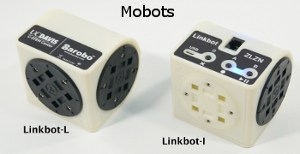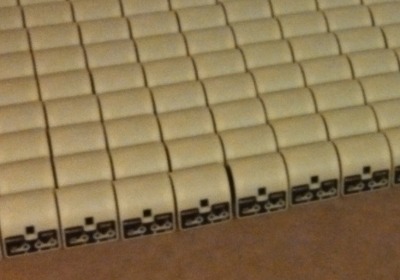 |
| July 16, 2013 | Volume 09 Issue 27 |
Designfax weekly eMagazine
Archives
Partners
Manufacturing Center
Product Spotlight
Modern Applications News
Metalworking Ideas For
Today's Job Shops
Tooling and Production
Strategies for large
metalworking plants
When 3D printing's not enough:
Proto Labs' short-run production scales up modular mini-robot manufacturing

The Mobot-L and Mobot-I Linkbots created by Barobo, Inc.
The word "robot" conjures images of metal men, of disembodied arms welding auto chassis, or of chainsaw-wielding battlebots in gladiatorial combat. Barobo, Inc.'s Mobot-L resembles none of these. Instead, it is a dimpled cube with one rounded face, rotating hubs on two of the other faces, and nary an arm or leg in sight.
Its older brother, the original Mobot, consists of two cubes hinged together, each with a rotating hub. The unorthodox design begins to make sense once you know that "Mobot" is short for "modular robot" and that one Mobot, joined with others and supplemented with simple accessories, can be an arm, a leg, a body, or virtually any moving part of a multi-module, software-controlled machine.
Mobots evolved from graduate work done by Graham Ryland at UC Davis in California. Ryland and his academic advisor, Dr. Harry Cheng, formed Barobo in 2010, initially to develop the modular robot concept for industrial applications. They quickly realized that the flexibility of their design made it ideal for STEM (science, technology, engineering, and mathematics) K-12 education programs, and in 2011 they were awarded a Phase One National Science Foundation grant to pursue that goal. In 2012, they were awarded a $500,000 Phase Two grant to complete development and commercialization of their product.
"Robotics is the next shop class, the new vocational education," says Ryland. "It gives students hands-on experience in electrical and mechanical engineering and computer science without having to develop systems from scratch." Each of Barobo's original Mobots has four degrees of freedom (two bending and two rotating) and up to seven can be joined into a single device. The newer Mobot-L has just two degrees of freedom, but an unlimited number of modules can be joined.
Each of Mobot-L's two motors is coupled with an encoder that senses the position of the rotating hub so the system can precisely follow instructions from the software. The Mobot-L also features plugs for external sensors and a speaker. The units are controlled wirelessly and can be programed in C++, a commercial language that students can carry over into other activities and careers. Accessories are available from Barobo or, if users have access to 3D printers, they can create them from templates or from their own designs.
Ryland points out that DARPA has been providing 3D printers to some high schools, and others, even middle schools, are buying their own.
Barobo initially produced all of Mobots' plastic components on 3D printers. "It was a slow process with no economies of scale," says Ryland. "Profits were minimal, but our primary goal was to build a community of Mobot users. That all changed when we got an order for 450 units, which would have taken our 3D printer nine months to produce running 24 hours a day. That's when we decided to mold parts and reached out to Proto Labs.
"Some of the parts we were making on the 3D printer would not have been moldable, so we had to do a fair amount of reengineering. I had help from Proto Labs' customer support and their online tools in the redesign process. Their level of customer support is second to none, and for molding-related aspects of design, their free online tools were more effective than anything I had in SolidWorks.

Multiple Mobots can be joined together to create an arm, leg, or body of a multi-module software-controlled machine.
"As an example of how much redesign we had to do, the first ProtoQuote design analysis I got back highlighted nearly a dozen required changes. We also changed the resins we were using. 3D printing didn't give us much choice of materials, so everything we printed was ABS. The Protomold process gave us many more choices, so for the main body parts we chose an ABS/polycarbonate blend, which is tough enough to stand up to rough handling in the classroom. For the hubs we used Delrin acetal for its high strength and wear resistance.
"We had Proto Labs make 11 different parts, some of which are quite complex with multiple side actions. Their aluminum soft tooling costs about half what other manufacturers would have charged for aluminum molds, and their turnaround time is a lot faster than we could get elsewhere, especially overseas. Aside from the speed and cost advantages over 3D printing, we like the material choices we get with the Protomold process. The molded parts have a smoother finish than we could get with 3D printing, and due to the layering process the 3D parts were brittle in some orientations. Overall, 3D printing was OK for producing hundreds of parts, but for thousands Proto Labs is a great choice.
"As orders continue to increase we may eventually go to hard tooling, but that's still a long way off. In the meantime we've fine-tuned our design to make it moldable, fixed weaknesses in the original design, upgraded our material choices to improve the performance and durability of our product, and significantly improved our profitability."
Source: Proto Labs
Want more information? Click below.
Published July 2013
Rate this article
View our terms of use and privacy policy
